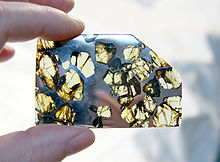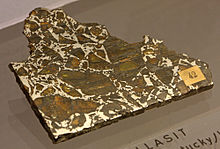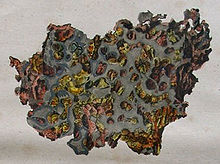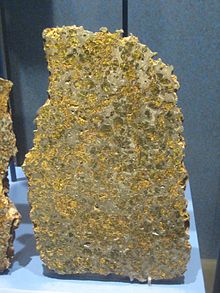- Pallasite
-
A pallasite is a type of stony–iron meteorite.
Contents
Structure and composition
It consists of cm-sized olivine crystals of peridot quality in an iron-nickel matrix. Coarser metal areas develop Widmanstätten patterns upon etching. Minor constituents are schreibersite, troilite, chromite, pyroxenes, and phosphates (whitlockite, stanfieldite, farringtonite, and merrillite).[1][2]
Classification and subgroups
Using the oxygen isotopic composition, pallasites are divided into 3 subgroups.[3]
- Main group (MG): almost all pallasites
- Eagle Station group (ES): counts only Eagle Station, Cold Bay and Itzawisis pallasites. Olivine is rich in iron and the metal matrix is rich in nickel. They are related to IIF irons.
- Pyroxene group (PX): counts only Vermillion and Yamato 8451. Take its name from the high orthopyroxene content (about 5%). Metal matrix shows a fine octahedrite Widmanstätten pattern.
Origin
Pallasites were once thought to originate at the core-mantle boundary of differentiated asteroids that were subsequently shattered through impacts. An alternative recent hypothesis is that they are impact-generated mixtures of core and mantle materials.[4]
History
A common error is to associate their name with the asteroid 2 Pallas but their actual name is after the German naturalist Peter Pallas (1741–1811), who studied in 1772 a specimen found earlier near Krasnoyarsk in the mountains of Siberia that had a mass of 680 kg.[5] The Krasnoyarsk mass described by Pallas in 1776 was one of the examples used by E.F.F. Chladni in the 1790s to demonstrate the reality of meteorite falls on the Earth, which were at his time considered by most scientists as fairytales. This rock mass was dissimilar to all rocks or ores found in this area (and the large piece could not have been accidentally transported to the find site), but its content of native metal was similar to other finds known from completely different areas.[6]
Pallasite falls
Pallasites are a rare type of meteorite. Only 61 are known to date, including 10 from Antarctica, with four being observed falls.[7][8] The following four falls are in chronological order:
- Mineo, Sicily, Italy. A luminous meteor was observed and an object seen to fall with a loud roar in May 1826. Only 46 g are preserved in collections.
- Zaisho, Japan. 330 g were found on February 1, 1898,[9] after the appearance of a fireball.
- Marjalahti, Karelia, Russia. After the appearance of a bright meteor and detonations, a large mass was seen to fall and 45 kg were recovered in June 1902. At this date the fall site belonged to Finland, and the main mass of Marjalahti is now at the Geological Museum of the University of Helsinki.
- Omolon, Magadan Region, Russia. A reindeer-breeder observed the fall on May 16, 1981, and found the 250 kg meteorite two years later. The fall was confirmed by a meteorological station that had observed a fireball on the same date.
Notable pallasite finds
Although pallasites are a rare meteorite type, enough pallasite material is found in museums and meteorite collections and is available for research. This is due to large finds, some of which yielded more than a metric ton. The following are the largest finds:
- Brenham, Kansas, USA. In 1890 the find of about 20 masses with a total weight of 1000 kg around the shallow Haviland Crater were reported. More masses were found later, including one of 454 kilograms (1,000 lb) from a depth of 5 feet (1.5 m), the total amounting to about 4.3 tonnes (4.2 long tons; 4.7 short tons). A piece of 487 kg is in the Field Museum of Natural History, Chicago. In 2005, Steve Arnold of Arkansas, USA, and Phil Mani of Texas, USA, unearthed a large mass of 650 kg and in 2006 several new large masses [10][11]
- Huckitta, Northern Territory, Australia. A mass of 1400 kg was found in 1937 on a cattle station north-east of Alice Springs. Earlier, in 1924, a transported piece of about 1 kg had been found on Burt Plain north of Alice Springs.
- Fukang, Xinjiang Province, China. A mass of 1003 kg was recovered in 2000.
- Imilac, Atacama Desert, Chile; known since 1822. Numerous masses up to 200 kg were found, the total weight is about 920 kg.
- Brahin, Gomel Region, Belarus, known since 1810. Many masses were found in a strewnfield, with a total weight of about 820 kg. An additional mass of 227 kg was found at a depth of 10 feet (3.0 m) in 2002.
- Esquel, Chubut, Argentina. A large mass of 755 kg was found embedded in soil before 1951.
- Pallasovka, Pallasovka, Russia. A single mass of 198 kg was found near Pallasovka, Russia in 1990. Coincidentally, both the town of Pallasovka and pallasite meteorites were named after the naturalist, Peter Pallas.
- Krasnojarsk, Yeniseisk, Russia. A mass of about 700 kg was detected in 1749 about 145 miles (233 km) south of Krasnojarsk. It was seen by P. S. Pallas in 1772 and transported to Krasnojarsk (see above) The main mass of 515 kg is now in Moscow at the Academy of Sciences. Pallasites are named after Peter Pallas for his study of this meteorite.
References
- ^ Buseck, P.R. (1977). "Pallasite meteorites: mineralogy, petrology, and geochemistry". Geochimica et Cosmochimica Acta 41 (6): 711–740. Bibcode 1977GeCoA..41..711B. doi:10.1016/0016-7037(77)90044-8.
- ^ Hsu, W. (2003). "Minor element zoning and trace element geochemistry of pallasites". Meteoritics & Planetary Science 38 (8): 1217–1241. Bibcode 2003M&PS...38.1217H. doi:10.1111/j.1945-5100.2003.tb00309.x.
- ^ O. Richard Norton. The Cambridge encyclopedia of meteorites. Cambridge, Cambridge University Press, 2002. ISBN 0521621437.
- ^ Edward R.D. Scott, "Impact Origins for Pallasites," Lunar and Planetary Science XXXVIII, 2007.
- ^ P.S.Pallas, Reise durch die verschiedenen Provinzen des russischen Reichs. St.Petersburg 1776
- ^ E.F.F.Chladni, Observation on a mass of iron found in Siberia by Professor Pallas, and other masses of the like kind, with some conjectures respecting their connection with certain natural phenomena. Philosophical Magazine and Journal of Science, 1798, vol.2, 1-8.
- ^ Meteoritical Bulletin Database
- ^ MetBase
- ^ Meteorites Japan
- ^ Mammoth meteorite unearthed, January 2006 about the October 2005 find
- ^ CNN: Unusual meteorite found in Kansas, October 16, 2006.
External links
- Pallasite images from Meteorites Australia - Meteorites.com.au
- (AP) "Unusual meteorite found in wheat field" October 17, 2006
- Legend of Glorieta Mountain Discovery of a large pallasite in New Mexico
Categories:- Meteorite types
Wikimedia Foundation. 2010.





